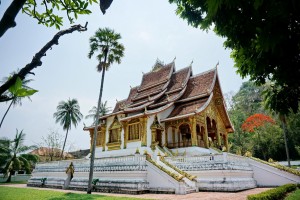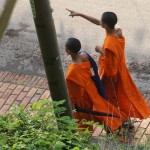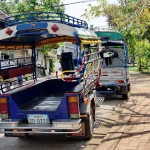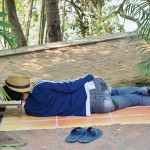The town is situated along the Mekong, where the river Nam Khan flows into it after a long turn, forming like a peninsula. Into this «peninsula» the old town has been placed. It had been the king’s residence since the 16th century and later became the capital during the period of Lao being a French colony. The residing kings have all built their own Wats (buddhistic temple with quarters for monks) and other majestic buildings over those 500years. We take it out of different books, that the architectural style is unique. Later during the French colonial time governmental buildings, offices and homes for all the officials in also quite a unique style have been set up over the whole «peninsula». This clear topographical defined area of the almost intact old town has been declared a cultural heritage form the UNESCO in 1995.
Naturally, we also visited some of these with gold and glass mosaik ornamented buddhistic or royal buildings. Colour and form are fascinating. Unfortunately there was almost no information about them or their use available. We did find books though later in the local library to answer few of our questions.
One morging we also went to see the daily alm-giving tot he monks. Buddhist cam earn merits for their karma in doing so. It also is a great picture, when in the early morning light the monks in their bright orange cloths come along the road in a long row.
Not only for it being a religious, sacred tradition tourist also take part in large numbers. They are manly looking for the monks, as it is a great picture. This picture calls also many tourist on the road. Nowadays food is sold to the tourists, who are then placed on the rows of colourful little plastic chairs to then hand the food to the monks. In a side road we found the locals, real buddhists, who are giving alm out of belief. Standing there a while, observing the modest sincere ritual we suddenly noticed, how some monks dropped the foodpacks earlier given to them by the tourists. (maybe they will be sold again….??)
The UNESCO label alone is like a magnet for tourist. They are almost flooding the place. The old town is now only consisting of Wats (temples) and colonial buildings that had been transformed into guesthouses, restaurants, tour-offices and handcraft shops. It is like an artificial town, calm, green with many gardens and lots of tourists. Due to the airport thousands of «Jet-tourists», those just jumping to Luang Prabang for a few days, as their only stop in Laos. That way a big load of money is flowing in, a for the country unusual high amount, causing a disproportionate increase in prices of all goods. However the quality doesn’t keep up with the prices. For example, you can get wood oven Pizza to a European price, but ants walk over the table; you find croissants even butter in 20g containers, but the butter is dark yellow from being rewarmed many times due to inconsistant cooling possibility…
There is an crowd of volunteers, working for some aid organisations and on every road there are sings of international development organisations. There is so much money put into this town, as the rest of the country together probably doesn’t get to see. There is corruption here too, by the way…
We doubt though that the population is able to digest this fast speed of change. And we fear, that the government and the population could rest in passivity despite the rapidly growing tourism and its growing demand. One shouldn’t forget, that the Lao have been subjects to kings for decades, buddhists and now the people of a communist country. All conditions not allowing to develop innovation, individualism or a sense to take on responsibility.






